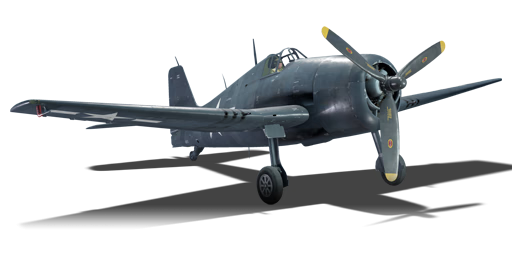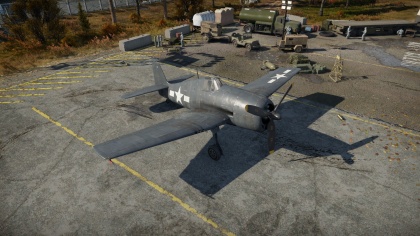Difference between revisions of "F6F-5"
Inceptor57 (talk | contribs) m (→Flight Performance: Modification to engine data table) |
Inceptor57 (talk | contribs) m (→Flight Performance) |
||
| Line 25: | Line 25: | ||
! colspan="4" | Engine characteristics | ! colspan="4" | Engine characteristics | ||
|- | |- | ||
| − | ! colspan="2" | Weight | + | ! colspan="2" | Weight (each) |
! colspan="1" | Type | ! colspan="1" | Type | ||
! colspan="1" | Cooling | ! colspan="1" | Cooling | ||
Revision as of 16:36, 2 September 2018
Contents
Description
The F6F-5 Hellcat is a Rank II American naval fighter with a battle rating of 3.0 (AB) and 3.7 (RB/SB). This aircraft has been in game since the start of the Open Beta Test starting out as the F6F-3 Hellcat and was remodeled and updated to the F6F-5 Hellcat in Update 1.65 "Way of the Samurai".
The Grumman F6F Hellcat was used extensively in the Pacific Theater of WWII. The Hellcat was the ultimate answer against extremely manouverable Japanese Zeroes. This plane greatly out performed the Zero when taking advantage of high speeds and altitudes. The Hellcat can carry versatile payloads which will allow it to be utilized in various operations to include ground attack.
General info
Flight Performance
Due to its role as a naval fighter, the F6F-5's take-off distance is small enough to take flight from the carrier decks seen in the game.
Powered by a high-output Pratt & Whitney engine, the F6F-5's flight performance centers around this powerful engine combined with a sturdy fuselage. While the bulk makes the plane quite sluggish compared to some of its contemporaries, the characteristics are still favorable for energy retention. This makes the plane very favorable for Boom-n-Zoom tactics against enemies.
| Engine | |||||
|---|---|---|---|---|---|
| Engine Name | Number present | ||||
| Pratt & Whitney R-2800-10w 18-cylinder | 1 | ||||
| Engine characteristics | |||||
| Weight (each) | Type | Cooling | |||
| 1,030 kg | Radial | Air | |||
| Engine power (Stock) | |||||
| Max | Take-off | ||||
| 1,803 hp | 2,000 hp | ||||
| Engine power (Upgraded) | |||||
| Max | Take-off | ||||
| 2,053 hp | 2,250 hp | ||||
Survivability and armour
Examine the survivability of the aircraft. Note how vulnerable the structure is and how secure the pilot is, whether the fuel tanks are armoured. Describe the armour, if there is any, also mention the vulnerability of other critical aircraft systems.
Armaments
Offensive armament
The F6F-5 Hellcat is armed with:
- 6 x 12.7 mm M2 Browning machine guns (400 rpg = 2,400 total)
The six machine guns are arranged in bundles of three on each wing. Each are armed with the same amount of ammunition, which means that all guns will fire with each other until empty.
The M2 Browning variant on the F6F-5 Hellcat is that of an earlier version of belts.
Suspended armament
The options available for the F6F-5 Hellcat are:
- 6 x 127 mm HVAR rockets
- 2 x 298 mm Tiny Tim rockets
- 2 x 1000 lbs AN-M65A1 bombs
- 6 x 127 mm HVAR rockets + 2 x 1000 lb AN-M65A1 bombs
- 1 x 2,216 lb Mk.13 Torpedo
Usage in the battles
The key to both surviving and owning in the F6F is to keep your speed up, and try to be even marginally higher then your opponents. Below 300 km/h (186 mph) it is very sluggish. As with most American fighters, boom and zoom is the preferred combat mode for the Hellcat, while its moderate high-speed maneuverability can be used to add in a high yo-yo. It has a lot of ammo, but a good aim is still important since boom-n-zoom only allows you a small window of opportunity to hit your target before you have to climb back to altitude. Still this is an excellent plane to practice your aim and tactics with because it's more forgiving than most boom-n-zoom fighters. If you don't have a particularly good aim, a good tactic is to open up at 500 m (0.31 mi), starting with your aim on the aircraft, and then slowly move your aim in front of the target. You won't require as much lead when diving on your target at 600+ km/h (373+ mph).
With dual 1000-pound bombs and six HVAR rockets armed, the Hellcat is actually a stable game-ending platform in a pinch when the rest of your team is not ground-attacking. The two Tiny Tim Anti-tank rockets can also be good for taking out heavier targets. Sometimes, it is useful to save the Cat as your last plane just for that. You can always jettison the rockets and bombs if you're suddenly forced to dogfight.
It is incredibly important to use Manual Engine Controls whilst piloting the Hellcat in Realistic or Simulator Battles. The Hellcat has access to three Supercharger gears, each tailored for a different altitude, and each will greatly improve your performance at their appropriate altitudes.
Keep in mind:
- It has a lot of engine power, but at anywhere between 5.7 and 7 tonnes, getting up to altitude isn't very easy.
- Resist the temptation to get into low-altitude turning fights. This is a heavy aircraft and it will lose a massive amount of speed in turns.
- While it has plenty of explosive armament options, in Realistic and Simulator battles the added weight and drag will usually make you an easy target for other fighters. Since most air battles are basically dogfights, you're often better off without the extra weight.
- This thing will perform reasonably well at low altitudes, but it's still recommended to stay at an altitude of 3 km or higher.
Pros and cons
Pros:
- Can carry a lot of payload for a Rank II aircraft.
- One of the few fighters that can carry a torpedo.
- Very effective in either air-to-air or air-to-ground, very versatile.
- Bombs are mounted directly under the fuselage, very accurate when dive bombing.
- Good climb rate.
- Very good dive rate.
- Good cockpit visibility.
- Extremely efficient cooling systems.
- Lots of ammo.
- Cheap repair cost.
- Can take some hits.
- Decent at energy fighting, although not as good as the 109 F-4.
Cons:
- You have to fly at a very low altitude at a very low speed to drop the torpedo, which is impractical.
- Only 3 salvos of HVAR rockets.
- Carrying the two 1000 lb bombs and the 6 HVAR rockets add also a worse climb rate.
- Slower top speed compared to other contemporary US fighters at similar BR.
- Higher stall speed than its Japanese counterparts.
- Control stiffening above moderate speeds.
- Poor roll rate.
- Large fuselage cross section makes it an easy target.
- Guns mounted further on the wings making it harder to aim at a target that is smaller than you.
- Despite its formidable reputation as the Zero killer, a Zero could still easily kill it if you are forced to fight on the Zero's terms.
History
The F6F Hellcat was Grumman's next fighter after the successful Wildcat. The F6F was designed from the start to be the ultimate answer against the Japanese Zero. The Hellcat was the planned replacement to the Wildcat since Pearl Harbor. The aircraft was designed from the start to be a much bigger airframe. The plan was to create a carrier based fighter with more ammo, fuel, and larger wings. The XF6F-1 Prototype was already in the works when the U.S. officially entered World War II. Grumman engineers knew they would have to create an aircraft that was faster and climbed better based on combat experience and data collected from the A6M captured in the Aleutians. The prototype flew in June of 1942 and was powered by a Wright Cyclone R-2600. The aircraft's performance was not satisfactory. The decision was made to replace the power plant with the Pratt & Whitney R-2800 Double Wasp.
The U.S. Navy needed a new carrier based fighter. The Corsair and the Hellcat were both competing to fill that role. With delays in the F4U Corsair project, the Hellcat took the role as the primary fighter and never looked back. The new Hellcat excelled in nearly every way over the A6M Zeroes it faced. The Hellcat unlike its opponents, featured self sealing fuel tanks and additional armour. The Hellcat quickly gained nicknames like "ace maker". The payload options helped transformed the Hellcat into a multi-role fighter that propelled it to legendary status. During its service life, the F6F was credited with the destruction of over 5,200 aircraft. It remained in service as late as 1954.
Media
An excellent addition to the article will be video guides, as well as screenshots from the game and photos.
Read also
Links to the articles on the War Thunder Wiki that you think will be useful for the reader, for example,
- reference to the series of the aircraft;
- links to approximate analogues of other nations and research trees.
ETC.
Sources
Paste links to sources and external resources, such as:
- topic on the official game forum;
- page on aircraft encyclopedia;
- other literature.





